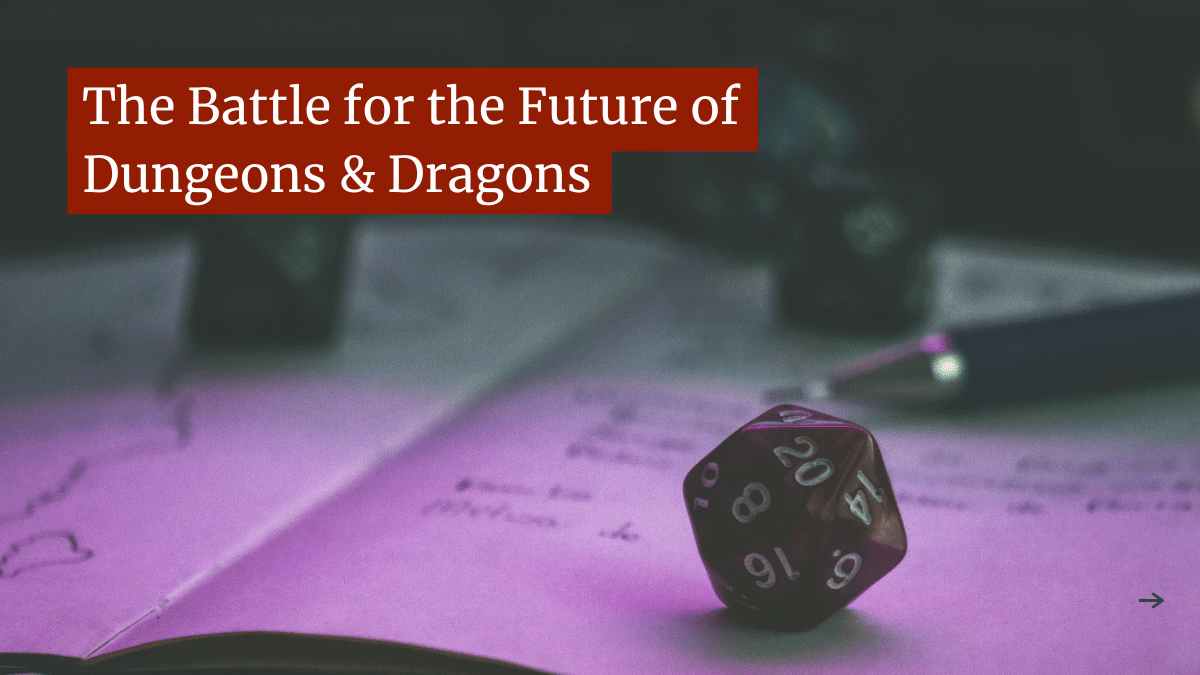The Battle Over the Future of D&D

Since the year 2000, much of what makes up the core of Dungeons & Dragons has been easily licensed for others to use.
That’s because the Wizards of the Coast (WotC), the rightsholders, licensed the System Resource Document under the Open Gaming License (OGL). That document is what outlines many of the core mechanics of the game, including classes, equipment and the general gameplay rules.
The OGL licensing of the document enabled a flourishing community of unofficial but fully licensed works. That includes separate role playing games that use the same core mechanics, add-ons for the D&D universe, apps and tools to make playing the game easier and much more.
However, much of that is likely to change.
Last week, Gizmodo reporter Linda Codega received a leaked draft copy of the upcoming OGL 1.1 license. This new license, if adopted as is, will represent a major landscape shift for not just the D&D community, but tabletop gaming broadly.
The changes have left many long-time D&D fans feeling angry and many creators, who are dependent upon the OGL, worried about the future of their work.
When one takes a deeper look at what is in the new version of the OGL, it becomes very easy to see why there’s so much anger.
What Changes in OGL 1.1
The new version of the OGL comes along with a planned revision to the rules of Dungeons & Dragons. Code-named One D&D, the changes were announced in 2022 with anticipation of a 2023 release.
But as that release nears, it’s the new version of the OGL that is drawing the lion’s share of the attention. That’s because the new version of the OGL brings many changes to the license, most of which are unwelcome by the fan base.
- Invalidates OGL 1.0: Though WotC has dabbled with other open licenses, OGL 1.0 always remained a valid option. That is no longer the case as OGL 1.1 is an update and a replacement, meaning that the 1.0 license will no longer be an “authorized license agreement.”
- Requires Reporting and Royalties: Creators who publish work for direct sale under the 1.1 license will be required to both report the works they publish to WotC, but also pay royalties if they earn more than $750,000 per year. While the royalties are unlikely to impact many creators, a number WotC estimates to be around 20 entities, any money earned over that amount will be subject to a 25% royalty. This means that a company earning $750,001 will owe just 25 cents in royalties. Kickstarter users get a discounted royalty rate of 20%.
- Strictly for Printed Media and Static Electronic Files: The new OGL only covers the “creation of roleplaying games and supplements in printed media and static electronic file format.” Other works, including apps, video games, virtual tabletops and so forth either have to be licensed directly with WotC or under their non-commercial Fan Content Policy.
- Claims Rights in OGL-Licensed Works: Whether the work is commercial or non-commercial, anyone who publishes under the OGL grants WotC a “nonexclusive, perpetual, irrevocable, worldwide, sub-licensable, royalty-free license to use that content for any purpose.” This is most likely to head off lawsuits of OGL-licensed authors accusing WotC of using their material illegally, but it still has many publishers worried.
- OGL Licensed Content Must Be Identified: Work published under the OGL must be clearly marked as such. This includes both including a logo on printed on the product, and some means of distinguishing between OGL content and new material in the document itself. To that end, they recommend using different colors, fonts or an index in the back of the work.
The consistent thing that runs through all these changes is that they are more restrictive, both in terms of what the license allows and how it is allowed. This is evident in the length of the two licenses, with the original OGL coming in under 900 words and version 1.1 containing more than 9,000.
It is worth noting that, while the Fan Content Policy is non-commercial, content licensed under it can be advertising supported or supported by donation as long as it is free for anyone to access. The commercial rules under the OGL only apply when one is directly selling the work or selling access to it.
Still, this represents a major shift in the way WotC is approaching OGL content and, given how much of a foundation the System Resource Document has been to tabletop gaming, it’s going to be a shift felt across the entire industry.
Why Fans Are Upset
While there are arguments to be made about whether using the OGL was a good thing or a bad thing for WotC or tabletop gaming more broadly, one thing can not be denied: It created a norm.
For over two decades, content creators and the gamers that depend on them have relied upon the OGL to create new works. Whether it’s expansions on D&D, whole new roleplaying games or just tools and aids to make tabletop gaming easier and more fun, the original OGL enabled it.
However, that is now being called into question. Setting aside the reporting and royalty requirements, the new OGL only is valid for printed materials for tabletop games. Couple that with the fact that WotC is granted a license to use all content published under the new OGL, and it’s easy to see why many are wary.
While it is true that many non-commercial uses will fall under the Fan Content Policy and WotC has said that they are open to drafting separate agreements for exceptions, the OGL provided a sense of stability in this space and now that is being taken away.
To make matters worse, the license would not give publishers and creators a great deal of time to adapt. The leaked draft was meant to be published on January 4, 2023 and to take effect on January 13, 2023. That is less than two weeks for others to get into compliance.
It is worth noting that it’s unclear exactly how this would impact works already published under the original OGL and WotC has not clarified this particular issue. However, with the original OGL no longer being a valid license, continued publication, either electronically or physically, would require complying with the new terms.
This means that this license, if it comes into effect, would cause a scramble across the industry to either comply with the new terms or change business models entirely.
Bottom Line
To be clear, WotC are within their rights here. From a legal standpoint, this is their content, and they can choose the terms they license it under, if any at all. Both legally and ethically, they are allowed to make this decision.
But that doesn’t mean it’s a good decision or the right decision.
With a single stroke, WotC is upending 20+ years of industry norms. While you can argue (and WotC does argue) that those norms were not fair to WotC and they were “subsidizing” their own competitors, you can’t argue that these are the rules that the entire industry has been built upon.
However, these norms also established WotC as a de facto leader in the tabletop gaming industry. Not only were they the biggest name in the space, but they were the foundation much of the industry was built upon.
This shift is likely to chip away at the latter point. Fans and creators alike are angry, with many calling for the creation or licensing of a new System Resource Document that is available under a true open license.
Even if WotC backtracks now, many creators and players alike are going to continue to mistrust both them and the OGL, with the realization that it can be taken away at a moment’s notice.
While that was always a risk, WotC’s actions turned a hypothetical problem into a real one.
Whatever happens from here, tabletop gaming won’t be the same. Creators and players can expect to see changes, even if it is impossible to know what exactly those changes will be at this time.
Want to Reuse or Republish this Content?
If you want to feature this article in your site, classroom or elsewhere, just let us know! We usually grant permission within 24 hours.
